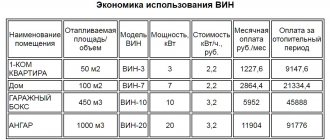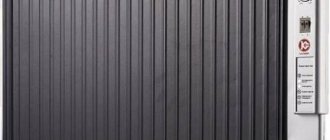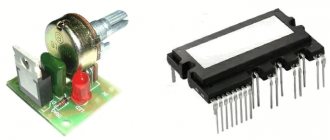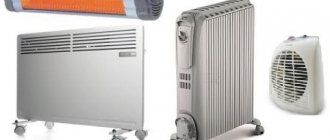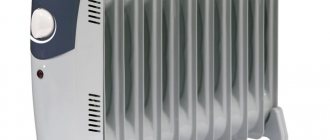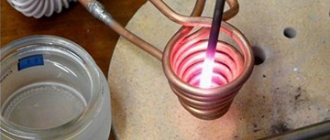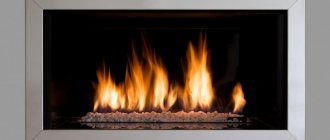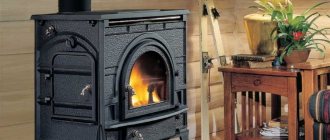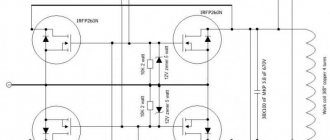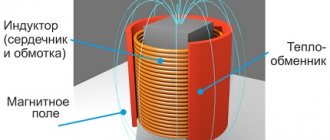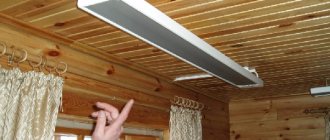Design and principle of operation of an induction heater
A simplified induction heater consists of three components:
- alternator (1);
- inductor (2);
- core (3).
A conductive (metal, graphite) rod is placed into a coil, consisting of a certain number of turns of a conductor of a given cross-sectional area, without direct contact with it, after which voltage is applied to the coil contacts from an alternating current generator. An electromagnetic field is formed around the turns of the coil, under the influence of which Foucault eddy currents arise in the rod, heating the core. Thus, there is no heat transfer to the core; heat is generated by it independently under the influence of currents wandering in it, and can be transferred using a coolant. The temperature of the rod does not increase simultaneously throughout the entire mass, but from the surface layers to the center, depending on the thermal conductivity of the core material. At the same time, increasing the frequency of alternating current reduces the depth of inductive heating, but increases its intensity. Particularly noteworthy is the fact that the coil around the core remains practically cold during operation.
Visually this process looks like this:
Areas of use
In industry, induction heaters are used to perform the following complex processes:
- ultra-pure smelting of metals (produced in channel - non-contact induction furnaces);
- bending of large diameter steel pipes;
- performing surface hardening of steel products (construction fittings, parts of machine tool transmission mechanisms, etc.);
- heat treatment of small parts of complex configuration;
In everyday life, induction heating devices are also quite widespread. Areas of their application:
- household autonomous heating systems (for a summer house, apartment, private house);
- induction hobs and tiles for the kitchen;
- small-volume crucible furnaces for household metal smelting;
- jewelry craft.
Since the main topic of the article is an induction heater, we will dwell in detail on a heating boiler, the basis of which is the idea of inductive heating of the coolant.
Induction heater – heating boiler
Since home owners began installing autonomous heating systems in their homes, the issue of the efficiency of heating boilers remains one of the most important for them. By this indicator, at least among devices that generate heat from electricity, induction heating boilers are the leaders. Moreover, their power, which is not comparable to the identical parameter of such a device as a baseboard heater, allows the units to be used as the main method of heating in large areas.
Induction heating boilers consist of two circuits - primary (electromagnetic) and secondary (heat exchange piping). The first circuit, consisting of a voltage converter and a heat generator with an induction heater, creates an electromagnetic field, eddy currents and generates heat. The second circuit, which includes a heat exchanger with a piping system, transfers this heat through circulation of the coolant to the radiators of the heating system. Water in its pure form or with additives is used as a coolant.
In addition to the above two circuits, the heating system includes automation, which is responsible for the operation of individual components of the unit.
Modern induction heating boilers are installed only in a closed-type heat exchange circuit, which has a membrane-type expansion tank and a forced circulation pump in its design. The use of a circulation pump is a necessary measure and is due to the small volume of coolant at a high heating intensity of the heat exchanger. The possibility of natural circulation in such a system is excluded - without a pump, water will boil before it begins to move through the pipes.
Important! The induction boiler must be grounded. In addition, when installing a heating system, for safety reasons, the coolant distribution circuit must be mounted from plastic pipes, or the heating unit must be isolated from the steel circuit by inserting polypropylene fittings.
Induction heating boilers are classified identically to other electric heating units - according to power, design, parameters of electricity consumed. But these devices also have a classification based on the design of the electrical part.
Induction Heater for Heating
An induction heater for heating is an electric heating device that operates on the principle of heating a conductor located in an alternating magnetic field and is used, as follows from the definition, for heating various objects, both residential and commercial. Let's consider the features of this type of heaters and understand their advantages and disadvantages.
►See Induction heaters for heating in our catalog
INDUCTION HEATER FOR HEATING: SOMETHING NEW OR OLD WELL USED?
Some manufacturers of induction heaters for heating talk about the uniqueness, cutting-edge and high-tech nature of their products. In terms of uniqueness, yes, most companies that mass-produce such products have patented developments for similar designs, and later we will tell you what this uniqueness is.
The very principle of induction heating has been known since the middle of the 19th century, and it is based on the phenomenon of electromagnetic induction discovered by Michael Faraday. The first induction heaters appeared at the dawn of the 20th century, after which they began to be widely used in the steelmaking industry, and then in mechanical engineering. Our contemporaries are familiar with induction heating from such a household appliance as an induction cooker. Somewhere in the mid-90s of the last century, the first industrial designs of induction heaters for heating began to appear.
OPERATING PRINCIPLE OF INDUCTION HEATER
One way or another, all induction heaters, whether domestic or industrial, operate on the same principle of a transformer, which consists of two circuits. The first circuit is the winding coils connected to the electrical network. The second is a heat exchange device through which the coolant circulates. When voltage is applied to the coil, it begins to generate an alternating magnetic field. A conductor (heat exchanger) located in an alternating magnetic field heats up under the influence of short-circuited eddy currents arising in it. From the surface of the heat exchanger, thermal energy is transferred to a coolant, which can be water or a mixture of water and ethylene glycol. Theoretically, an induction heater can heat any liquid, which significantly expands the scope of its application in industry. Naturally, this requires agreement with the manufacturer.
WHAT IS THE UNIQUENESS OF AN INDUCTION HEATER FOR HEATING
It would seem that the design of an induction heater is not anything complicated, the transformer is a well-known and common device, what is unique about the design of induction heaters for heating? The fact is that you can assemble an induction heater with your own hands, but the energy efficiency of such a boiler will be very doubtful. Induction heaters produced commercially have an efficiency close to 100% (98-99%) and a power factor of the order of 0.98-0.985. To achieve such indicators, it took years of painstaking work by scientists from the Novosibirsk Electrotechnical Institute - it was their developments that formed the basis of the most famous brands of induction heaters on the market. Today, each manufacturer has patented design features that they carefully protect.
It is also important to note that an induction heater for heating is a heater operating at an industrial current frequency of 50 Hz. This is its fundamental difference from high-frequency and ultra-high-frequency inductors intended for heating and melting metals in metallurgy. An induction heater for heating does not have complex and expensive frequency converters, since it is not tasked with achieving high heat exchanger temperatures. Thanks to the developed heat exchange surface, the temperature difference between the heat exchanger and the coolant does not exceed 15-20 °C with proper circulation, therefore, in a normal situation, the heat exchanger temperature does not exceed 100-115 °C.
►See Induction heaters for heating in our catalog
DIFFERENCES OF INDUCTION HEATERS FROM OTHER TYPES OF ELECTRIC HEATERS
Currently, heating elements, electrode and induction electric heaters are widely used. All of them convert electrical energy into thermal energy. Only the method of this transformation differs. So, in a heating element boiler, a tubular electric heater is heated, consisting of a housing, a dielectric and an incandescent filament. An electrode boiler heats the coolant due to the electric current passing through it. We have just looked at the operation of an induction heater. What is the difference, and most importantly, what is better?
In terms of energy efficiency – parity. All types of electric heaters have an efficiency of about 100%, that is, almost all electrical energy is converted into heat. Here one could argue that electric heating is the most expensive, but electric heaters have too many advantages for them to be discounted. So, in terms of efficiency, all electric heaters are approximately equal. But this is if we take ideal conditions - prepared coolant, new heating elements and electrodes, but over time, the heating element, due to the high specific heat load, begins to become overgrown with scale, as a result of which its heat transfer and efficiency drops. The heating power of the electrode boiler also decreases over time, and although its power consumption also decreases proportionally, the boiler is purchased for this purpose in order to produce as much heat as needed. This does not happen with an induction heater. Firstly, scale deposition on the walls of the heat exchanger due to the relatively low heating temperatures is not so intense; secondly, the energy characteristics of an induction heater do not depend on the chemical composition of the coolant and the service life of the heater.
MAIN ADVANTAGES OF INDUCTION HEATERS USED IN HEATING SYSTEMS:
- extreme durability and reliability. There are no moving parts in the device, there is no mechanical wear. If the winding and coil are made properly, they can last for decades. An induction heater will last much longer without breakdowns than other types of heat generators for heating. In this case, there is no need to change failing heating elements and electrodes - the heaters simply do not have them.
- high electrical safety. In an induction heater, there is no contact between the conductive elements and the coolant; the heat exchanger is heated indirectly and the touch voltage to it is almost zero. The electrical safety of an induction heater corresponds to the second class (for example, a heating element boiler has electrical safety class 1; an electrode boiler has a zero class, this means additional investments in ensuring the safety of the equipment)
- Fire safety. There are no high temperature elements, connections or seals in the induction heater.
As a result, we can say that in terms of efficiency, an induction heater for heating is not superior to other types of electric heaters, which is not surprising: perhaps only scammers can talk about an efficiency exceeding 100%. But in terms of efficiency during operation, an induction heater will surpass both heating elements and electrode boilers - it is more unpretentious, more reliable and will not require any additional costs or hassle. When used correctly, an induction heater can operate for several decades.
►See Induction heaters for heating in our catalog
WHERE IS IT MOST PROFITABLE TO USE INDUCTION HEATERS?
Each product has its own niche. Induction heaters also have such a niche. The fact is that such equipment is more expensive than heating elements and electrode boilers. Firstly, the consumption of materials and, consequently, the cost are higher; secondly, the share of intellectual labor is higher. All other things being equal, an induction heater for heating will be more profitable where the need for powerful equipment is higher - from 25 kW and above. And the greater the need for power, the more units of heaters it is planned to install, the more profitable it will be to purchase an induction heater, since the savings on operation and maintenance of the equipment will be more serious.
INDUCTION HEATER TERMANIK FOR HEATING
NPP "Thermal Technologies" from Novosibirsk is one of the leading manufacturers of induction heaters for heating, known on the market under the brand name TERMANIK. What are the advantages of this brand over others? Firstly, this is our own unique design, developed jointly with NSTU researchers and patented by the enterprise. Secondly, this is a proven design, used in hundreds of large and small enterprises throughout the country and the CIS. Thirdly, this is one of the best offers on the market in terms of a set of consumer properties. And finally, fourthly, this is a certified production quality system and a Gold Medal for quality.
The company’s specialists are ready to make a qualified calculation of the quantity, power and cost of equipment for the customer’s task based on the technical specifications. These calculations are carried out free of charge for customers.
Types of induction boilers
There are the following types of induction heating boilers, designated both by the principle of operation and by the manufacturer’s brand:
- SAV is a type and at the same time a trademark of new generation boilers with a power from 2.5 to 100 kW, produced by the Russian company since 2007;
- VIN - the abbreviation is not only an abbreviation for the name of a type of induction device (vortex induction heaters), but also a patented name for boilers produced by Izhevsk.
Induction heaters SAV
Operation of SAV units does not require the use of an inverter; a current of 50 Hz is supplied to the inductor. The electromagnetic field induced by the primary winding causes the formation of vortex flows in the secondary winding, the role of which in boilers of this type is played by a section of a closed circuit of pipes with coolant. This section of the pipe - the secondary winding - is intensively heated under the influence of Foucault currents and transfers heat to the coolant, which is forced to circulate in the heating system using a circulation pump.
The heating system is constructed using radiators or in a labyrinthine manner, reminiscent of baseboard heating, in order to increase the total area of the outer surface (heat transfer) of the pipes - the heating circuit, at a minimum, should not be minimal in length.
SAV boilers are manufactured for voltages of 220V and 380V. They use water as a coolant (pure or with antifreeze additives), as well as antifreeze. It takes about 5-20 minutes for the unit to reach full operating power (depending on the volume of coolant), the efficiency of the heaters of such devices is at least 98%. For efficient heating of a room up to 30 square meters. An induction device with a power of 2.5 kW is sufficient, the purchase of which, complete with automation and control systems, will cost approximately 30 thousand rubles.
VIN heating units
Boilers of this type are more advanced in operating principle and design, which naturally affects their cost. To operate VIN devices, an inverter is required - a device for increasing the frequency of the incoming current. High frequency current causes the formation of an electromagnetic field of high intensity, which, in turn, causes the occurrence of more powerful eddy currents in the secondary winding. In addition, the heat exchanger and boiler body are made of ferromagnetic alloys that have their own magnetic field. The result of all these processes is a high heating intensity of the heat exchanger and, naturally, the coolant.
A VIN unit with a power of 3 kW is enough to heat a room with an area of 35-40 square meters. (depending on climatic conditions and the quality of thermal insulation of external building structures).
Due to their greater productivity, VIN units can be used not only in residential heating systems, but also for hot water supply. To do this, additional storage tanks equipped with automatic protection are installed into the coolant circuit, the capacity of which is calculated depending on the number of hot water intake points. These containers are provided with hot water by circulating it in a system with direct-flow heating by an induction heater.
Basic operating principles
Operating principle of an induction boiler
Already from the name of induction heating one can understand that the operation of such boilers is based on the principle of electromagnetic induction. And to understand exactly how the system works, it is enough to pass a large current through a coil of thick wire. An electromagnetic field will definitely appear around this device, and quite a strong one. And if you put any ferromagnet in it - that is, that metal that is attracted, then it will heat up - and quite quickly.
Search the site otoplenie-doma.org
So, the simplest example of induction heating, that is, a heat source, is a coil that is wound on a dielectric pipe.
A steel core must be placed inside. The coil, which is connected to a source of electricity, will heat the metal rod. Now all that remains is to connect the device to the main line where the coolant circulates, and such primitive induction heating with your own hands will begin to work.
To briefly describe the principle of operation, it will require only a few judgments. Electrical energy creates an electromagnetic field. The metal core is heated by electromagnetic waves. Excess heat from the rod goes to the coolant, heating it.
Inverter heating boilers
The coolant in such systems can be not only ordinary water, but also ethylene glycol and oil. Due to the fact that the liquid is heated intensely, convection currents are obtained. The hot coolant rises, and its power is already enough for a small circuit to work. If the line is long, then it is necessary to install a circulation pump.
Heating system with induction boiler
Evaluation of marketing characteristics-statements
Many advantages are attributed to induction heating boilers, often without argument. Let us list these characteristics and evaluate the degree of correspondence of the statements to the fact:
Economical
Statement
Electricity consumption by induction boilers is 20-30% less than other electric heaters.
Fact
All heating electrical devices that do not perform mechanical work convert 100% of the energy of electric current into heat; their efficiency is always below 100%, but differs in value for different devices under different conditions. To generate 1 kW of thermal energy, it is necessary to consume more than 1 kW of electricity, but how much more depends on the parameters of the dissipation medium. Inside the boiler, of course, there are also losses - for example, for heating the coil, since any conductor material has resistance, but all these losses remain indoors
Important! Old-style meters (bakelite) will record less (1.6 - 1.8 times) electricity consumption than modern electronic ones, since they are not designed to take into account the reactive power of induction boilers.
Perhaps this fact explains the statement about the efficiency of induction boilers.
Durability
Statement
High reliability and long service life of the equipment - more than 25 years.
Fact
Indeed, the absence of moving parts eliminates mechanical wear of induction boilers. But the heating system with a VIN unit includes a circulation pump, the resource of which is much more modest. In addition, the control and automation system includes mechanisms that also consist of many components that are subject to wear.
The core of an induction heater operates under conditions of constant cyclic heating and cooling, temperature deformations, which are also a negative factor. Therefore, calling the resource of induction boilers almost limitless is an exaggeration. However, it is indeed several times higher than heating element heaters.
Consistency of characteristics over the entire service life
Statement
The absence of scale formation on the inner surface of the pipes ensures the constant efficiency of the heater and heat exchanger.
Fact
Scale is the deposition of salts contained in water (coolant). The amount of these impurities in a limited volume of coolant is also limited and small, so the effect of scale on the efficiency of the heater is insignificant. And in an induction boiler, the secondary winding is under almost constant vibration, and scale formation does not occur at all. So the statement is correct, only its significance is exaggerated.
Silence
Statement
The operation of induction heating boilers is silent, which distinguishes them from other electric heaters.
Fact
The statement is true, but all electric boilers do not make noise during operation, since acoustic waves are not included in their oscillation range. Only the circulation pump can make noise, but if you wish, you can choose a silent model.
Compactness
Statement
Induction boilers are compact, which is convenient when choosing their installation location.
Fact
This is true if you do not use a cascade of induction boilers and do not install intermediate tanks if there are several hot water intake points in the hot water supply system, since an induction heater is, by and large, a small piece of pipe with a winding.
Safety
Statement
The safety of the device is absolute.
Fact
There are no absolutely safe electric heaters. When operating induction devices, the possibility of coolant leakage from the system cannot be ruled out, and the electromagnetic field generator will continue to operate, and the system of empty pipes will heat up. To prevent the occurrence of such a situation, the boiler design provides an automatic shutdown device, but it can also fail.
Therefore, induction heaters, while outperforming their competitors in some safety criteria, are not completely safe.
What is an induction boiler?
Induction heating systems began to be used in the 80s of the last century in industrial enterprises. Household appliances appeared only in the mid-nineties. Over the past decades, they have been refined and some updates have been made to their design, however, the principle of their operation remains unchanged.
The name of these heating systems and devices in itself indicates that their operation is based on electromagnetic induction. The essence of the operating principle is that if an alternating current is passed through a wire of a sufficiently large diameter cross-section, wound in the form of a coil, then a powerful electromagnetic field is created around this primary winding. If there is a conductor in this field, then voltage will be induced (induced) in it. Well, if the field lines intersect a core made of an alloy with magnetic properties located in it, then a kind of short-circuited circuit is obtained. And due to the appearance of stray Foucault currents on it, very fast and strong heating of this material occurs.
The simplest diagram of the operating principle of an induction heater
This principle is widely used, for example, in the steel industry. They also found a use for it for fast and high-temperature heating of water. It is clear that the core in this case will be a pipe or other channel through which the coolant circulates.
And the most understandable example of an induction heater is a wire wound around a pipe made of a dielectric, which will insulate a magnetic core placed in its interior.
The wire coil is connected to the power supply and creates an electromagnetic field. As a result of exposure to an alternating electromagnetic field, the metal core rod will heat up, transferring heat to the coolant, which then enters the pipes and radiators of the heating circuit. Oil, water or ethylene glycol can be used as a coolant in autonomous heating systems.
Instead of a core, modern boilers use a whole labyrinth of channels and pipes for heat exchange. Their walls, made of a ferrimagnetic alloy, provide a large area of contact with water and therefore very intense heating of the coolant circulating through them
This is, of course, a very simplified explanation. In industrial induction boilers, the heat exchange ferromagnetic core can be a whole labyrinth of pipes or channels, and often, for example, in vortex heaters, the body of the device is also involved in this process.
One induction boiler of correctly selected power is capable of providing heated coolant to several circuits of an extensive heating system. Naturally, with proper placement of collectors and circulation pumps.
In heating systems of short length, the coolant, when heated, will rise upward, and the created natural pressure is usually sufficient for its natural circulation. If the heating main is quite long and branched, connected to collectors with further distribution of coolant flows along separate circuits, then one or more circulation pumps are installed in the system, since without them the required coolant movement will be impossible to achieve.
Disadvantages of induction heaters
- High cost of devices.
- Considerable weight yet compact.
- The presence of a factor influencing the electromagnetic field on the body and devices.
Let's look at the last point in more detail.
The electromagnetic field affects living organisms in much the same way as food in a microwave oven - it heats them to a certain depth, and this can have consequences. The intensity of the field's influence, including on a person, is determined by such an indicator as the energy flux density (EFD), which increases with increasing frequency of the current supplied to the primary winding. When operating induction heaters, it is necessary to comply with the sanitary norm of the limit value of PPE, which is established in SanPiN 2.2.4/2.1.8.055-96, depends on the duration of exposure to the field and is, for example, for an 8-hour exposure - 25 μW/sq.cm, one-hour – 200 µW/sq.cm.
In addition, the inductor radiation negatively affects electronics and radio equipment located nearby, creating interference during operation.
Important! To protect yourself from the effects of electromagnetic fields, you can surround the boiler with a fine-mesh (1x1, 2x2 mm) metal mesh (Faraday cage), which is not in contact with the boiler body and is grounded.
Induction heaters
►See Induction heaters in our catalog
INDUCTION HEATERS: WHAT COMMON?
No matter how trivial it may sound, what induction heaters have in common is the induction heating method. We have already examined in detail the operating principle of induction heaters and their difference from other types of electric heaters.
Any induction heater will consist of a primary winding (inductor) and a secondary winding - a heat exchange device. The heat exchange device is a short-circuited coil that is heated under the influence of an alternating magnetic field induced by inductive coils (hence, in fact, the name itself - “induction heater”). In general terms, the principle can be illustrated as follows:
Moreover, interestingly, it is impossible to patent this principle - it is based on elementary physical laws and is accessible to everyone. For example, power engineers know such a property of a transformer as its heating during operation. Only in the case of a transformer, heat generation is a headache for power engineers, but in the design of an induction heater this property is elevated to the absolute, and today manufacturers claim that they have achieved an efficiency of 98, or even 99%. Manufacturers generally love the efficiency indicator, because this indicator is relative, and therefore you can declare anything, and not be afraid of responsibility: under certain conditions, you can declare that the efficiency is generally 100% - that’s why it is a relative coefficient.
Induction heaters: unity and struggle of opposites
So what are these patented differences then? It turns out to be mainly in the design of the heat exchanger. Of course, there are differences in the design of the magnetic cores and in the design of the coils - they can be elongated, flattened, they can differ in the material of the wire and the number of turns, but the essence does not change. The task of the primary winding is to generate an alternating magnetic field, and in any heater it copes with this. So there are practically no differences in the heating method between induction heaters from different manufacturers. But significant differences lie in the designs of heat exchangers. What’s interesting is that there is currently no generally accepted classification, so let’s take the liberty of proposing our own, so:
- Shell type induction heater
- Induction heater with tubular heat exchanger
- Induction heater with a volumetric heat exchanger (inductive-conductive type electric heater - that’s what the manufacturer calls it)
Shell type induction heater
Let's start with the first one - the “shell-type induction heater”. Manufacturers of such heaters call them differently, but in this article we are not interested in the names, but in the heating principle.
We called this type of induction heater “shell” because externally this type differs from others in that manufacturers place the heater structure (i.e. inductor and heat exchanger) inside a cylindrical shaped casing. Outwardly, it even somewhat resembles an electrode boiler, but differs from the latter in the way it heats the coolant.
Inside the casing there is an elongated inductor, inside and outside of which there is a heat exchanger that heats up under the influence of an electromagnetic field. Passing through the heat exchanger, the water is heated and supplied to the heating system.
Design advantages:
- More compact, has smaller dimensions and weight than other types of induction heaters. There is an opinion that it also looks better aesthetically, but this is debatable, firstly, and is not decisive for an industrial heater, secondly.
- Less material-intensive (the heat exchange device consists of “ferrous” metal grade St3sp) compared to other representatives of the class, and therefore it has a lower cost and, accordingly, a lower purchase price.
- Can be placed on the wall (other induction heaters are floor-mounted only)
Design disadvantages:
- Making a heat exchanger from ordinary metal reduces the cost of the structure, but makes its elements more susceptible to corrosion, especially during periods of maintenance and draining of the coolant.
- The design of the heat exchanger is such that it has increased hydrodynamic resistance, as a result of which the speed of the coolant decreases when it enters. This can lead to two troubles at once: firstly, to the deposition of contaminants present in the coolant in the lower part of the heater and, subsequently, to even greater difficulty in the flow and, secondly, to a decrease in heat removal from the surface of the heat exchanger. In general, the design of such heaters assumes a fairly high heat flux density - 9-10 W/cm2, and the deterioration of heat transfer will cause boiling in the boundary layer of the coolant. This is fraught with accelerated deposition of scale in such places (in fact, over the entire area of the heat exchanger), as well as a further decrease in heat transfer and, ultimately, overheating of the heating circuit.
- The disadvantage from the previous point is aggravated by the fact that the design is not repairable - the cost and time of repair will be approximately the same as the cost and time to purchase a new heater.
- Also, the vertical location of the heat exchanger leads to the fact that gases and air dissolved in the coolant, during the heating process, will collect in the upper part of the heat exchanger, displacing the coolant from there, which can lead to local overheating of the heat exchanger due to the lack of necessary heat removal, and the heat load of the heater, as we indicated above is quite large.
- Despite the fact that one of the main advantages of induction-type electric heaters is the provision of class 2 protection against electric shock (i.e., almost absolute protection even without grounding), this feature, alas, does not apply to the design of this type of heaters, since if the insulation of the inductor windings is broken, the coolant will be energized - just like a heating element boiler.
- Shell-type induction heaters are limited in heating power and temperature. The power of a single heater, as a rule, does not exceed 70-100 kW, and the maximum coolant temperature is 100-110 °C (however, this is enough for a conventional heating system). Power limitation leads to the need for parallel installation of several heaters.
Conclusion: the design of shell-type induction heaters has become quite widespread, mainly due to the ease of manufacture, relatively low cost (and, consequently, the selling price) and the distribution system through dealers (the margin of the product allows it to be shared with intermediaries). However, this type of heaters only conditionally refers to heaters of the “transformer” type, and does not always deservedly use in its statements the advantages that are inherent in this type of heaters.
Induction heater with tubular heat exchanger
To be frank, the first commercial success of induction electric heaters of the true transformer type was accompanied by this particular design of induction heaters, which appeared on the market in the mid-90s of the last century and became quite widespread. What makes them special:
Firstly, these heaters are no longer hidden in a casing. Of course, they do not shine with special beauty, but their other properties are important for the buyer. Secondly, here the inductor coil (primary winding) is completely separated from the heat exchanger (secondary winding), which eliminates electric shock: even if the insulation of the windings is broken, the electrical network cannot be closed to the coolant, so this is a real 2nd class of electrical safety. And finally, thirdly, the heat exchange device here is a set of tubes that go around the inductor coils.
Otherwise, everything is the same as with all other induction heaters - the coils excite a magnetic field, which, passing through the metal of the heat exchanger, excites eddy currents in it, which heat it up, and then the heat is removed by the coolant with forced circulation.
Design advantages:
- The design is close to a “dry” transformer, and, therefore, with the proper high quality of production, it has such properties as durability (up to 100,000 hours), electrical safety and high reliability (in any case, higher than that of “shell heaters” and many times higher than for heating element heaters).
- Availability of large powers per unit of equipment (up to 500 kW of power in one heater). Similar to shell induction heaters, tubular induction heaters can also be installed in parallel and the power required will then be limited only by power availability and thermal energy demand.
- The ability to provide high heating temperatures (up to 250-300 °C), which significantly expands the scope of application of heaters. It is no longer limited to the area of heating and hot water supply. Using a high-temperature liquid coolant, it is possible to replace steam heating systems in industry (reactors, presses, etc.) with liquid ones, which significantly increases the reliability, safety and controllability of heating processes.
- In general, when compared with heating elements and electrode boilers, many advantages can be noted. Our main task is to compare with other types of induction heater designs.
Design disadvantages:
- Possibly uneven distribution of heat flow across the cross-section of the heat exchanger pipe. Due to uneven ohmic resistance and surface effect, the largest part of the thermal energy (calculated, up to 70%) can be released in only 30% of the pipe surface on the winding side. The heat flux density in these zones is comparable to the heat flux density of a conventional heating element. Which can lead to local overheating, vaporization in the boundary layer of the coolant and deposition of salts on the walls of the pipe, with subsequent deterioration in heat transfer and, as a consequence, local overheating. The effect of scale formation is greatly enhanced in places where pipes are welded, due to the high current densities in these joints.
- Despite the claimed power factor of 0.98, the effect of increased magnetic flux dissipation around the tubular coils most likely reduces this coefficient to 0.9, otherwise explaining that to provide the same thermal power, heaters with a tubular heat exchanger have higher power consumption and currents in the windings? This in turn results in higher costs for the consumer because they have to use larger gauge wires, and also increases the manufacturer's cost (and therefore the purchase price for the buyer).
- A tubular heat exchanger has increased hydrodynamic resistance, which leads to the need to install more powerful (and expensive) circulation pumps.
- The heater weight is increased because the tubular configuration of the heat exchanger requires a significant gap between the transformer core rods. This leads to an increase in the yoke of the magnetic core of the transformer and an increase in the cost of the product as a whole.
- Although the inductor coils are reliably impregnated with insulation, they are not protected in any way from accidental or (even worse) targeted mechanical impact, which, of course, does not increase the reliability of the heater.
- The tubular heat exchanger is not repairable, and in case of failure it must be completely replaced at the manufacturing plant.
Conclusion: induction heaters with a tubular heat exchanger are, in principle, the first commercially successful induction heaters, and this is really a step forward compared to heating element boilers and shell-type heaters, and just two steps forward in relation to electrode boilers (due to safety factors). The use of a tubular heat exchanger was initially dictated by technological limitations and financial issues, since a tubular heat exchanger is easier to manufacture than a volumetric heat exchanger (which will be discussed later), but it is not without shortcomings, which manufacturers are not allowed to correct within the framework of patent legal relations.
Induction heater with volumetric heat exchanger
The volumetric type of heat exchanger, in the form of prototypes, appeared even earlier than the tubular one. However, the first designs were not very successful - perhaps there is no point in describing them, since now, if they are produced, they are made at home. We will be interested in the latest iteration of the design, which the manufacturer also calls an inductive-conductive heater. Of course, this is just a way of positioning the product, but this name very clearly reflects the essence of this heater.
Induction heaters with a volumetric heat exchanger appeared already in the 21st century, and during their creation, the shortcomings of all other designs were undoubtedly taken into account. What is the design of an inductive-conductive electric heater with a volumetric heat exchanger?
As we can see from the figure, the design is quite reminiscent of an induction heater with a tubular heat exchanger, however, instead of tubes, a hollow cylinder is used here, inside of which there is an inductor. According to many (including the author), inductive-conductive induction heaters look aesthetically better than heaters with a tubular heat exchanger, since the volumetric heat exchanger also acts as a casing: the appearance creates a feeling of completeness and some kind of security.
This is also a full-fledged induction heater, the design of which is similar to a “dry” transformer. And it, of course, has all the advantages that follow from this: high reliability, durability, fire and electrical safety, since the primary winding to which voltage is applied is separated from the heat exchanger, which eliminates electric shock: this is a full 2nd class of electrical safety .
Eddy currents here arise in the thickness of the metal from which the hollow cylinder is made. It should be immediately noted that the design solution itself increases the reliability of the heater and its resistance to damage. Judge for yourself: the windings of the inductor coils, which can be easily damaged in a heater with a tubular heat exchanger, are reliably protected from external influences here. Of course, they will not save you from a stubborn pest, but accidentally damaging the inductor is much more difficult.
The heat exchanger material here is AISI-304 stainless steel, so it is not in danger of corrosion.
The only place that can be classified as a bottleneck (and which competitors like to mention) is the welds on the heat exchanger, because, unfortunately, mankind has not yet learned how to cast hollow cylinders without seams. But humanity has learned to weld parts well. The case with volumetric heat exchangers is no exception.
Design advantages:
- An inductive-conductive electric heater is as close as possible to the design of a “dry” transformer, and, therefore, has such properties as durability (up to 100,000 hours or, in terms of years, about 30 years!), electrical safety, high reliability and all other advantages compared with heating elements and electrode boilers.
- Availability of large powers per unit of equipment (up to 500 kW of power in one heater). There are also modifications of high-voltage induction boilers that can provide heating power in excess of 6 MW. Similar to other induction heaters, induction heaters with a volumetric heat exchanger can also be installed in parallel, and thus provide any heating power.
- The ability to provide high heating temperatures (up to 200-250 °C), which significantly expands the scope of application of heaters. This is slightly lower than that of tubular heat exchangers, which is precisely due to the design. The tubes provide better ventilation and cooling of the coils. In induction heaters with a volumetric heat exchanger, the coils are closed, however, the temperatures provided by these heaters are sufficient for many technological processes (heating reactors, galvanic baths, drying chambers, presses, etc.).
- The uniform distribution of heat flow over the more developed surface of the heat exchanger guarantees the absence of local overheating, scale deposits and a very small temperature gradient between the coolant and the heat exchanger (no more than 20 ° C), which serves as an additional argument in favor of the reliability and fire safety of an inductive-conductive type heater.
- “Honest” high power factor of 0.98-0.985 due to more uniform absorption of the magnetic field by the cylindrical heat exchanger.
- Lower weight of heaters compared to tube heaters of similar power.
Flaws:
- Higher cost of materials and high-tech production: high quality and excellent consumer properties do not come cheap.
- Low margins (markups) make the product uninteresting for intermediaries, so products must be ordered only from the manufacturer.
- In most cases, the heat exchanger is not repairable, however, the risk of its failure is the lowest of all types of induction heaters. In addition, its replacement can be carried out by the operating organization, and not just by the manufacturer.
►See Induction heaters in our catalog
Conclusion: if we say that induction heaters are the next step in relation to heating elements and electrode boilers, then inductive-conductive heaters with a volumetric heat exchanger are an example of further development of the design, which is perhaps closer than ever to the expected ideal. The main thing, in the presence of a very good and energy-efficient design, is a high culture and quality of production, which would strictly follow the design documentation and fulfill the plans of engineers and scientists who spent years creating such complex, but such simple equipment as an induction electric heater.
Operating rules
The safe operation of induction heating boilers, like any other technical devices, is ensured by following a number of rules regarding both their installation and use after installation:
- Boiler grounding is mandatory.
- The distance from the device to the walls on the sides must be at least 30 cm, from the bottom point of the boiler to the floor - 80 cm, from its top point to the ceiling - 80 cm.
- Induction boilers are installed only in a closed circuit with a membrane-type expansion tank.
- The system must include a block of safety devices (pressure gauge, air valve, overpressure relief valve, automatic shutdown system for overheating).
Review of famous manufacturers
- Edison - induction heaters with a power from 4.7 to 500 kW, produced by Novosibirsk, for domestic and industrial needs;
- Miratron is a product of the Russian manufacturer of induction heating equipment NPK Miratron for domestic use, characterized by an advanced design that allows the use of the equipment without damaging the interior of the room;
- Teco-House are induction heating boilers with a unique control system, produced by the Ukrainian company of the same name according to EU and Russian Federation standards.
